Per impostazione predefinita, WordPress visualizza i post del blog nella home page. Tuttavia, se state creando un sito web aziendale o semplicemente volete personalizzare la vostra homepage, potreste volere una pagina separata per la sezione blog.
Questa configurazione non solo aiuta a mantenere la homepage pulita e focalizzata, ma fornisce anche uno spazio dedicato ai lettori per esplorare i contenuti del blog.
Per migliorare l’esperienza dell’utente e mantenere un focus chiaro sulle nostre offerte, abbiamo aggiunto pagine blog separate su molti siti web delle nostre aziende partner, tra cui WPForms, OptinMonster e All in One SEO. Questo permette ai visitatori di accedere facilmente ai contenuti del blog, dando al contempo la priorità all’obiettivo primario di promuovere i nostri plugin.
In questo articolo vi mostreremo due modi per creare una pagina separata per i post del blog in WordPress.
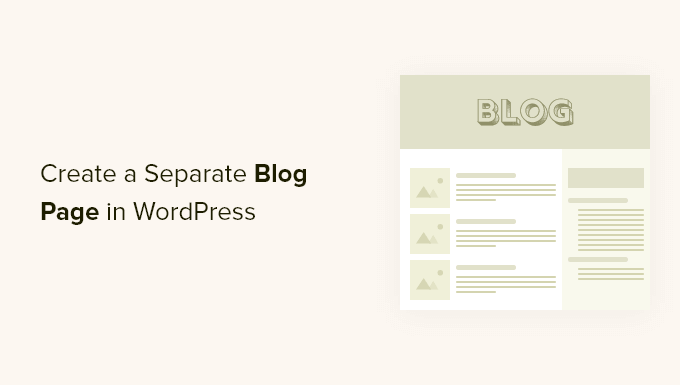
Perché visualizzare i post del blog in una pagina separata?
La home page è la pagina principale del vostro sito web WordPress e la prima pagina che i visitatori vedono. Per impostazione predefinita, WordPress mostra i post più recenti sulla home page, e questo ha senso se gestite un blog.
Ma non è sempre l’ideale per i siti web delle piccole imprese. Probabilmente vorrete una home page più accattivante, che illustri agli utenti la vostra attività, i vostri prodotti e servizi, consenta loro di sapere come contattarvi e aumenti la conversione delle vendite.
Ora, se volete gestire anche un blog sul vostro sito web, dovrete fornire un’altra pagina in cui i visitatori possano leggere i vostri post.
Detto questo, vi mostreremo come creare facilmente una pagina separata per i post del blog in WordPress.
In questa esercitazione abbiamo discusso due metodi e potete usare i link sottostanti per passare al metodo che preferite. Tenete presente che il secondo metodo è il più semplice e offre la massima personalizzazione:
Video tutorial
Se preferite le istruzioni scritte, continuate a leggere.
Metodo 1: Creare pagine separate per i post del blog in WordPress
È possibile creare una pagina separata per i post dei blog utilizzando le impostazioni predefinite di WordPress.
Tuttavia, questo metodo richiede un po’ più di lavoro rispetto al metodo 2 e non offre altrettante opzioni di personalizzazione.
Creazione di una pagina iniziale e di una pagina del blog separate
Per prima cosa, è necessario creare due pagine WordPress separate da utilizzare come homepage e pagina del blog.
Non è necessario aggiungere alcun contenuto a queste pagine e si può dare loro il nome che si preferisce. Ad esempio, alcuni siti web aziendali utilizzano “News” per la loro pagina blog.
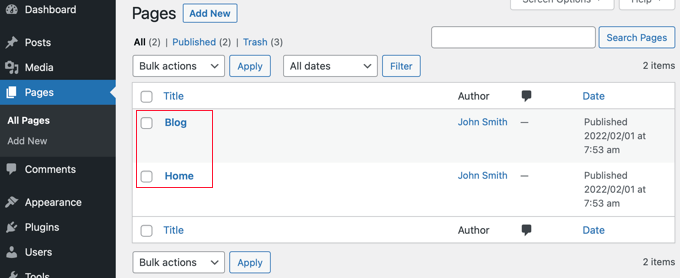
Una volta create queste pagine, visitate la pagina Impostazioni ” Lettura nell’area di amministrazione di WordPress.
A questo punto, nella sezione “Visualizza la tua homepage”, è necessario fare clic sul pulsante “Una pagina statica”.
Successivamente, è possibile selezionare le pagine Home e Blog create in precedenza. Scorrere verso il basso e fare clic sul pulsante “Salva modifiche”.

Ora, quando si accede alla schermata Pagine ” Tutte le pagine dalla dashboard di WordPress, si vedrà che la pagina Home è etichettata come ‘Prima pagina’ e la pagina Blog come ‘Pagina dei post’.
Fare clic sul link “Visualizza” sotto la pagina del blog per visualizzare l’anteprima.
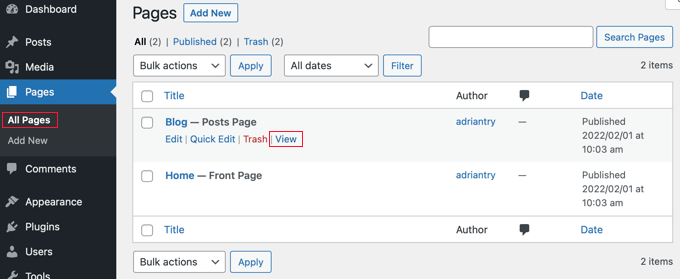
L’aspetto di queste pagine dipende dal tema di WordPress e si consiglia di configurare queste impostazioni.
Ad esempio, se il vostro tema ha un menu di navigazione, noterete che WordPress ha aggiunto automaticamente le nuove pagine Blog e Home. In caso contrario, consultate la nostra guida per principianti su come aggiungere un menu di navigazione in WordPress.
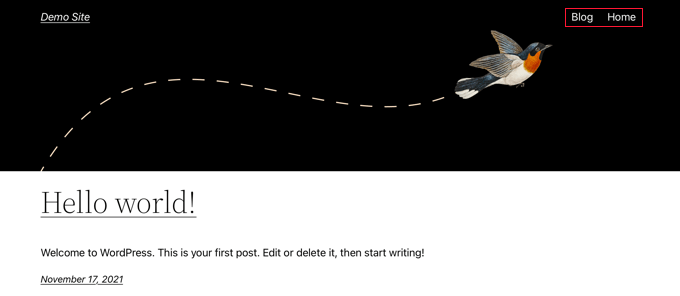
Personalizzazione della pagina iniziale
Finora la vostra nuova home page è vuota. Ora è il momento di aggiungere informazioni sulla vostra attività, sui prodotti e sui servizi e di far sapere ai visitatori come possono contattarvi.
Potete imparare a farlo nella nostra guida su come creare una home page personalizzata in WordPress. Nel Metodo 1, vi mostriamo come utilizzare l’editor di blocchi per aggiungere immagini di copertina, colonne, tabelle, testo e media, gallerie e altro ancora.
Troverete anche molte idee di personalizzazione creativa nella nostra guida su come modificare una home page di WordPress in modo semplice ed efficace.
Personalizzazione della pagina del blog
Se siete soddisfatti dell’aspetto della pagina del vostro blog, il vostro lavoro è finito.
Tuttavia, se attualmente si utilizza un tema a blocchi, è possibile personalizzare la pagina del blog visitando la schermata Aspetto ” Editor dalla dashboard di WordPress.
Una volta arrivati, selezionare l’opzione “Pagine” dalla colonna di sinistra nell’editor completo del sito.
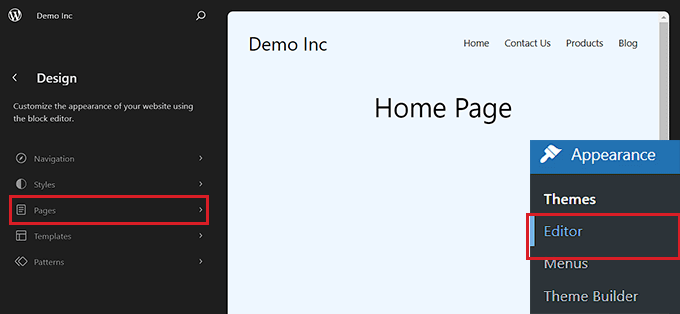
Si aprirà un elenco di tutte le pagine del vostro sito web nella colonna di sinistra.
Da qui, selezionare l’opzione della pagina ‘Blog’ e poi fare clic sull’anteprima della pagina a destra per iniziare a personalizzare la pagina del blog.
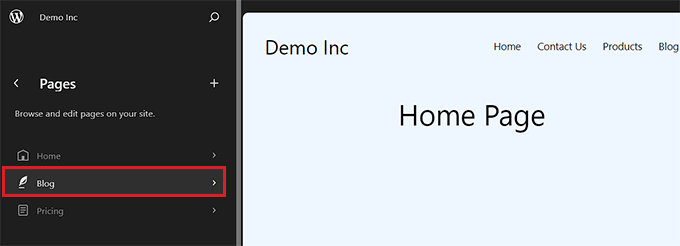
A questo punto è possibile fare clic sul pulsante “+” nell’angolo in alto a sinistra dello schermo e aggiungere alla pagina i blocchi desiderati.
Inoltre, è possibile modificare il colore dello sfondo, del testo o dei link della pagina del blog facendo clic sull’icona “Stili” nell’angolo in alto a destra dello schermo.
Si aprirà un pannello di blocco sulla destra da cui si può fare clic sulla scheda “Tipografia” per cambiare il colore del testo, sulla scheda “Colori” per cambiare il colore dello sfondo e sulla scheda “Layout” per configurare le dimensioni della pagina del blog.
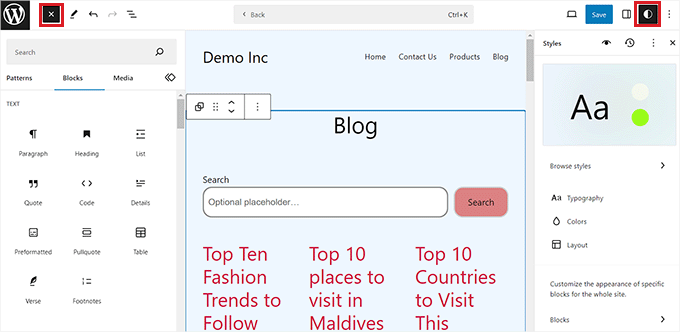
Una volta terminato, non dimenticate di fare clic sul pulsante “Salva” in alto per memorizzare le impostazioni.
Ora è possibile visitare la pagina del blog WordPress per vedere come appare.
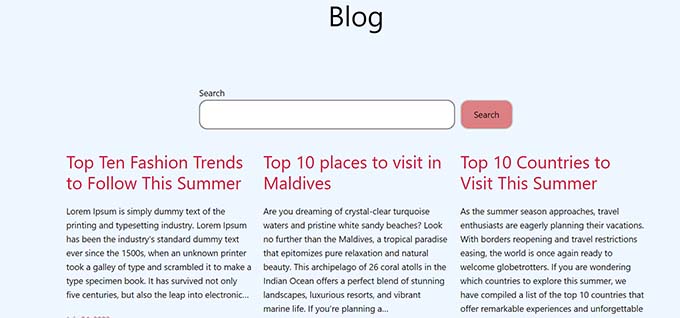
Tuttavia, se si utilizza un tema classico, è necessario utilizzare il metodo 2 per personalizzare la pagina dei post del blog.
Metodo 2: Creare una pagina personalizzata per i post del blog con un costruttore drag & drop (consigliato)
Un plugin per la creazione di temi consente di creare facilmente un tema WordPress personalizzato senza alcun codice. Questo include la possibilità di creare e personalizzare una pagina separata per i post del blog.
Installazione del costruttore di temi SeedProd
Per prima cosa, è necessario installare e attivare il plugin SeedProd. Per maggiori dettagli, consultate la nostra guida passo passo su come installare un plugin di WordPress.
SeedProd è il miglior costruttore di pagine WordPress drag-and-drop per aziende, blogger e proprietari di siti web. Dispone anche di un designer di temi che consente di personalizzare facilmente la pagina del blog e molto altro ancora.
Per maggiori dettagli, potete leggere la nostra recensione completa di SeedProd.
Dopo l’attivazione, visitare la pagina SeedProd ” Impostazioni per inserire la chiave di licenza. Queste informazioni sono disponibili nel proprio account sul sito web di SeedProd.

Dopodiché, è il momento di creare un tema WordPress personalizzato. È molto più semplice di quanto sembri.
Creare un tema WordPress personalizzato
Per prima cosa, è necessario visitare la pagina SeedProd ” Theme Builder. Qui si utilizzerà uno dei temi già pronti di SeedProd come punto di partenza. In questo modo si sostituirà il tema WordPress esistente con un nuovo design personalizzato.
È possibile farlo facendo clic sul pulsante “Temi”.
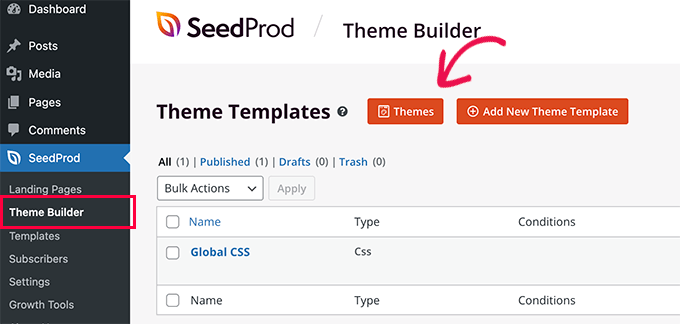
A questo punto vi verrà mostrato un elenco di temi professionali progettati per diversi tipi di siti web.
Ad esempio, esistono modelli chiamati “Modern Business”, “Marketing Agency” e “Mortgage Broker Theme”.
Date un’occhiata alle opzioni e selezionate quella più adatta alle vostre esigenze facendo clic sull’icona del segno di spunta.
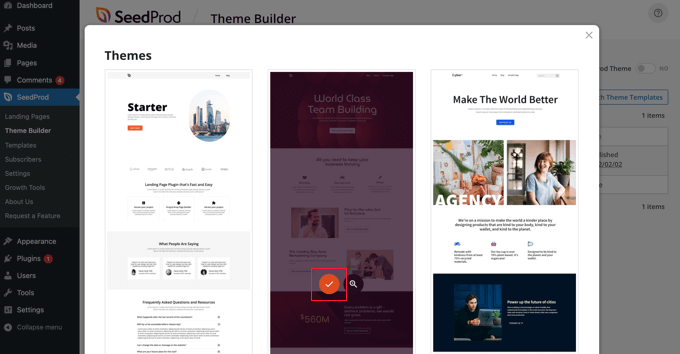
Una volta scelto il tema, SeedProd genererà tutti i modelli di tema, tra cui uno per l’indice del blog e uno per la pagina iniziale.
Non si tratta di pagine vuote, ma di layout accattivanti e di contenuti segnaposto facili da personalizzare.
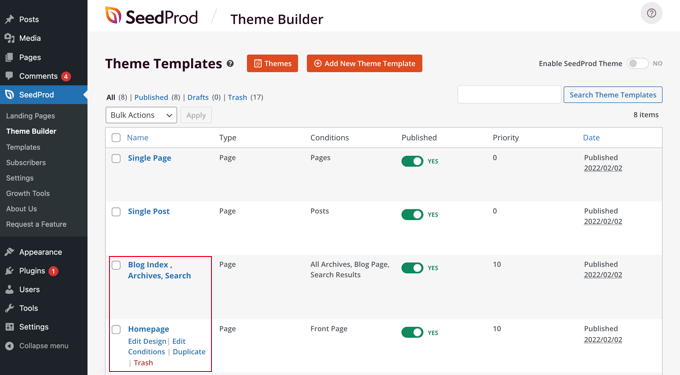
In questo tutorial vi mostreremo come personalizzare i modelli della home page e dell’indice del blog.
Potreste anche voler personalizzare gli altri modelli. Per sapere come fare, consultate la nostra guida per principianti su come creare facilmente un tema WordPress personalizzato.
Personalizzazione della pagina iniziale
Una volta generati i modelli del tema, è possibile modificarli utilizzando il costruttore di temi SeedProd. Inizieremo con il modello Homepage.
Per iniziare, è sufficiente fare clic sul link “Modifica design” sotto la homepage.

In questo modo si avvia il file del modello nel costruttore di temi SeedProd.
Questo semplice costruttore drag-and-drop mostra un’anteprima live della pagina a destra e una barra degli strumenti di blocco a sinistra.
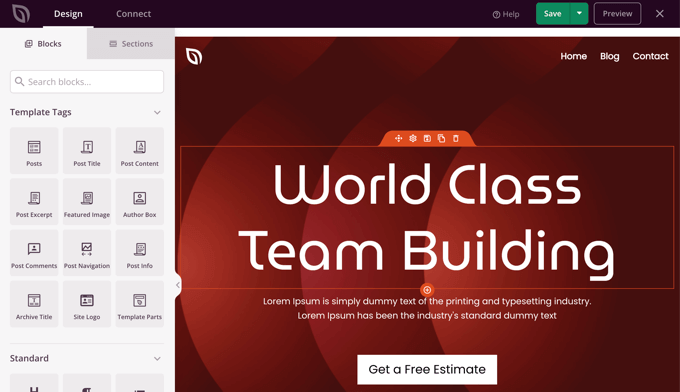
È possibile personalizzare qualsiasi blocco facendo clic su di esso, trascinando i blocchi in alto e in basso con il mouse e aggiungendo nuovi blocchi alla pagina.
Abbiamo scritto una guida completa su come creare una home page personalizzata in WordPress. Basta scorrere fino al Metodo 2 per imparare a personalizzare la vostra home page utilizzando SeedProd.
Personalizzazione della pagina del blog
Il costruttore del tema SeedProd offre anche molte possibilità di personalizzare la pagina di indice del blog.
Per iniziare, fate clic sul link “Modifica design” sotto la pagina.

Vedrete lo stesso riquadro di anteprima sulla destra e la barra degli strumenti sulla sinistra. È possibile personalizzare la pagina del blog nello stesso modo in cui si è fatto con la pagina iniziale.
Ad esempio, facendo clic sul titolo, è possibile visualizzare tutte le sue impostazioni. È possibile modificare il testo, cambiare l’allineamento e la dimensione dei caratteri e altro ancora.
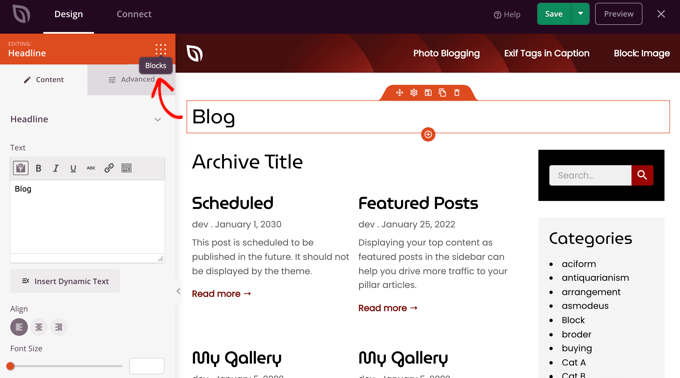
Una volta terminato, è necessario fare clic sull’icona ‘Blocchi’ per tornare alla barra degli strumenti.
Il costruttore del tema SeedProd offre ulteriori blocchi Template Parts, come il blocco Posts, che visualizza un elenco dei post del blog.
Il blocco Messaggi è già stato aggiunto al modello dell’indice del blog; in questo modello, il blocco visualizza i messaggi in due colonne. Possiamo cambiarlo in una singola colonna.
È sufficiente fare clic sul blocco Messaggi e modificare l’impostazione ‘Colonne’ in 1.
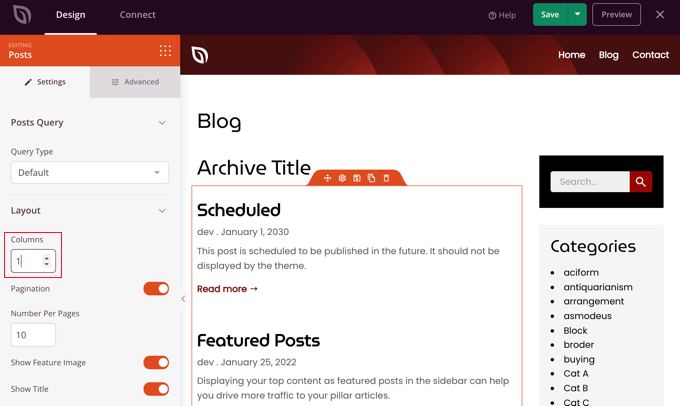
Il layout cambierà immediatamente in una singola colonna.
Scorrendo le impostazioni del blocco Messaggi, si trovano dei selettori che consentono di scegliere se visualizzare o meno l’immagine caratteristica e il titolo del post. Si può anche scegliere quale tag di intestazione utilizzare per il titolo del post.
Sono disponibili anche opzioni per la visualizzazione di diversi metadati dei post. È possibile modificare la data di modifica, l’autore, la data e l’ora di pubblicazione e il numero di commenti.
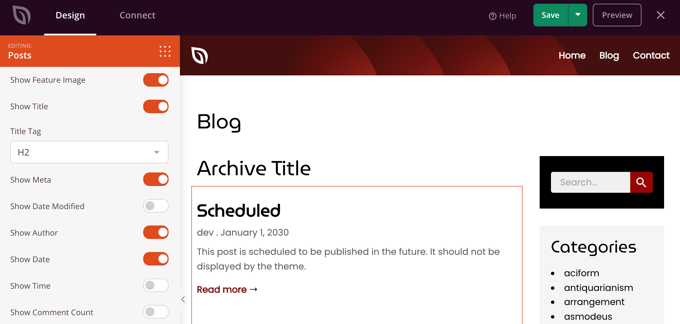
Ecco altri modi per personalizzare l’indice del blog:
- È possibile filtrare l’indice per tipo di post, categoria, tag o autore.
- L’ordine dei messaggi può essere modificato.
- È possibile scegliere quanti post visualizzare in una pagina.
- È possibile attivare l’estratto del post e personalizzarne la lunghezza.
Una volta terminata la personalizzazione della pagina del blog, assicurarsi di fare clic sul pulsante “Salva” nella parte superiore della schermata. Quindi, è possibile tornare all’elenco dei modelli facendo clic sull’icona “X”.
Abilitazione del tema SeedProd
Una volta terminata la personalizzazione dei modelli di tema, è necessario pubblicare il nuovo tema personalizzato.
È sufficiente spostare l’impostazione “Abilita tema SeedProd” su “SÌ”.
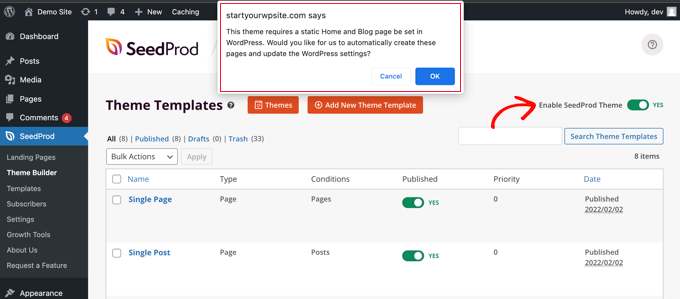
Verrà immediatamente visualizzata una notifica che indica la necessità di modificare le impostazioni delle pagine Home e Blog di WordPress. Facendo clic sul pulsante “OK”, queste impostazioni verranno modificate.
Ora è possibile visitare il sito web per visualizzare la nuova home page e la pagina del blog. Ecco come appare la pagina indice del blog sul nostro sito demo.
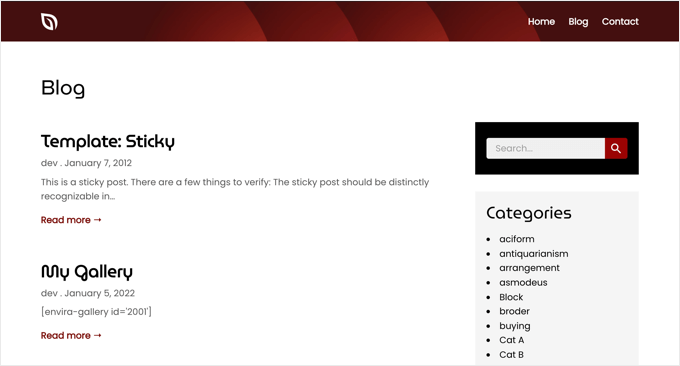
Bonus: visualizzare i post recenti in WordPress
Una volta creata una pagina blog separata, potete comunque mostrare alcuni post recenti nella vostra home page per incoraggiare gli utenti a esplorare meglio il vostro sito.
Per farlo, aprire la propria homepage nell’editor di blocchi di WordPress. Una volta lì, fate clic sul pulsante “Aggiungi blocco” nell’angolo in alto a sinistra dello schermo per aprire il menu dei blocchi.
Da qui, è sufficiente aggiungere il blocco “Ultimi messaggi” alla pagina. Una volta fatto ciò, è possibile personalizzare l’elenco dei post recenti per visualizzare gli estratti dei post, i nomi degli autori e le date secondo le proprie preferenze.
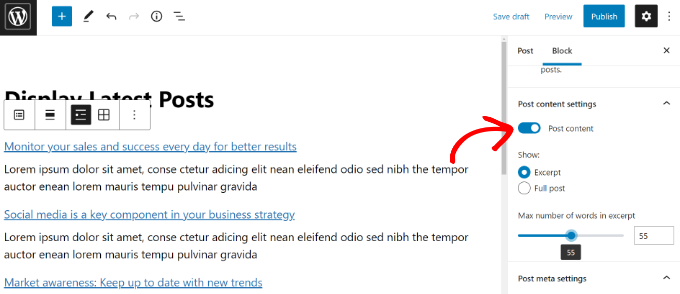
Infine, fare clic sul pulsante “Pubblica” in alto per salvare le impostazioni. Ora, alcuni dei vostri post recenti saranno ancora visualizzati nella home page per garantire che gli utenti trascorrano più tempo sul vostro sito web.
Per maggiori informazioni, potete consultare il nostro tutorial su come visualizzare i post recenti in WordPress.
Speriamo che questo tutorial vi abbia aiutato a imparare come creare una pagina separata per i post del blog in WordPress. Potreste anche voler imparare come aggiungere uno stato personalizzato per i post del blog in WordPress o consultare il nostro elenco dei migliori plugin per i post correlati per WordPress.
Se questo articolo vi è piaciuto, iscrivetevi al nostro canale YouTube per le esercitazioni video su WordPress. Potete trovarci anche su Twitter e Facebook.





Krystian
I can’t figure that one out
I wanted to add some guest posts to my blog, but I want them to be in the separate category (available thru the menu).
For that I created new category, put it up in the menu and I selected the guest post to be visible only in that category (tick box), but when I publish it, it appears in both: my guestpost category (available from the menu) and on my main .com site, where I have all my other posts listed.
How can I turn it off from the main site?
Krystian
Sarah
Hi, just started my blog and am wondering How many posts WordPress keeps on the same page before having a “see older posts” button at bottom to take you to the next page? My homepage is getting longer and longer by the minute lol. Thanks!
Rhys
Hi Sarah,
You can change the amount of posts you show per page in WordPress Admin > Settings > Readying. The default is 10 from what I understand, although you can change this to whatever you feel like. The more posts per page, the slower load times you may incur.
All the best,
Ruth
Very clearly explained and wonderfully helpful. I had my blog page up and populated within minutes of watching your video. Thank you!
Ronnie
I load the sample page created by wordpress on localhost, it show properly BuT WHEN I access it thru another computer on a different internet, it show not properly.
nishant saraswat
i create my website at wordpress and now i want to create my site user friendly and beautiful i know html and some of javascript,css and php but not completly.i want to create my site beautiful either from some codings or from without codings.so,please help me to create my website.that how i create functions for users to look my site comfort to them please tell me whole process.i create a website by hostgator and sent you my reciept details.please help me i have followed you.
WPBeginner Support
First you need to choose a theme. After that if you want to further customize then you can create a child theme. There are several tools that you can use like CSS Hero and a page builder to quickly create beautiful pages with out writing much code.
Admin
Maya
What if those options are not available under template when creating a new page?
WPBeginner Support
The template names may vary from one theme to another.
Admin
Sally E
Hello,
I’m using the customizr theme and I like how it looks with blog posts showing up on the home page for now.
I would also like to have a “blog” page that links to blog posts as well since later I’ll be writing items that won’t go under the blog tab.
Is there a way to have the blog posts show up on the home page as well as on a separate page?
Thanks in advance!
Rosalinde
I have the same problem, I would love to know how to use the default homepage of the theme and a blog page that links to blog posts.
chibueze
Please, why is it that when I post in my blog, it displays all the contents of my post on that page, including images and Writings
WPBeginner Support
By default WordPress shows full post on all pages. This can be changed by using excerpts. Please see our guide How to customize WordPress excerpts no coding required.
Admin
Michelle
Like many others, I’ve been trying everything to figure this out…thank you for making it so easy!!!
Kristy
After a long, frustrating day of trying to figure this out, I will sleep a little better tonight. It now seems so obvious but for some reason, I just couldn’t figure it out today. I googled and read several forum posts where everyone said this was impossible & you just had to create category to handle a blog. I really didn’t like the way this looked on my site but decided I would just have to deal with it until I figured something else out. Thanks so much for this video. You have made my day! Now I’m going to check out your other articles hoping they will be helpful with my hundreds of other questions.
Tuncay
Hi,
I have a news website, I want to create a Forum Page, but the forum page should be take the news from other pages and my visitors can disscuss under the news in forum page,
how cna it be possilbe?
could you please help me on this?
Thanks
WPBeginner Support
See our guide on how to add bbPress forum for WordPress posts comments. This approach allows you to add a forum thread for each article you publish.
Admin
Harshit
Hi ,
This is a very helpful video. It really helpful to me. thank you for the tutorial. And you have a very nice voice.
thank you,
Zach
Helpful, thanks.
But it looks like my theme only has one template (“Default Template).
When I go to Pages, and try to Quick Edit my page, I only see “Default Template” in the dropdown of “Templates.”
Am I able to add/import more templates into my current theme? I couldn’t find a WPBeginner tutorial on this…
Thanks,
Zach
WPBeginner Support
Seems like your theme does not have a separate template for blog posts. You can try using the default template and see if it does what you need. Alternately, you can create a custom template of your own. See our tutorial How to create a custom page in WordPress. Please note that it requires some basic knowledge of html and php.
Admin
Zeeshan Ali Kaimkhani
good project
Gary
Grerat video, Thanks But when I changed the posts to the blog page, my custom theme home page is also showing the blogs. How do I keep the current custom theme home page and just move the blogs to the new blog page?
Thank you in advance.
Gary
WPBeginner Support
Please contact your theme support.
Admin
Mohsin
Hi thanks for your tutorial.
but i have problem
i am creating custom theme and i have multiple option on page for example page layout and enable top slider on this page but when i select posts page : blog
custom options are not working.
Elizabeth
Wonderful! Been searching for a very simple and straight forward tutorial, glad I found this site!
Lara
Your tutorial was awesome, thank you so much! So simple and straightforward, you helped me get my blog up and running in a few minutes. You rock!
Debbie
My problem is that on the blog page, where just the excerpts are, it reads about the first 55 words of my blog posts, but then there is no “More” or anything for them to click to read the entire post. How do I create that? They can click the image of the post, and it takes them to the full post, but there is no information that says to do that. I’m stumped!
Stephanie
OMG this was SO helpful. As a novice blogger I was finding it so impossible to create a blog post page and include that page on my menu. I can’t tell you how many times I attempted to do this in the most complicated ways. Thank you for the EASY and FAST tutorial! I am so happy!
Diane Lee
Thank you for this tutorial. I’m new to WordPress, and this was very helpful!
Ted Sherwood
Syed and team. First, thanks for a very helpful site. It’s now the first place I go to for WordPress help.
I have a theme that allows my latest posts or a static page for the front page. I already have many blog posts. And I have an existing page that I could use, with a couple of additions probably, as my front page. So I interpreted the above article as implying that I don’t need to create any new pages. However, when I try and follow your Settings/Reading instructions, there is no option under Posts for the blog page, just all the other existing pages. Perhaps there’s something I’ve missed?
WPBeginner Support
The article does mention that you need to create a new page for your blog posts.
Admin
Jason G
Very helpful especially if you have not been using a blog and are only accustomed to static pages on your sites. Thanks!
Arfa
Hey syed
Though the article is really helpful and I am succeeded in adding pages to my blog but can you please tell me how to add a post in that particular page like i have added page titled as food for thought and i have to add a post in that, how can i do that ?
Please advice.
Patti
I’m having the same issue….
Harold Buchman
Excellent tutorial –
One thing to look out for:
My custom blog page did not work while I was signed in as the administrator on my WP control panel in another browser window. As soon as I signed out, the link worked exactly as describe.
Charli
I don’t have the reading settings option… do you know what i should do ?
Abel
Good enough i hadn’t yet published my website to the world This is so helpful.. I would have forget-en how to do this and ended up ridiculously frustrated.
Heather
Thanks for the help—but I have another question kind of related..
Every post i create in my wordpress is appearing in my BLOG section..even though I do not have the ‘blog’ category (or any for that matter checked before publishing.
Here’s my site – –can you help
elizabeth
What if I want to create 2 pages but those 2 pages should have my blog posts. for eg: one page should blogs about clothing and another page should have blogs about “jewellery”
Judi Sutherland
My understanding is that you can’t have two pages of blog – only one on any site. Unless anyone knows different.
Steve
You can have as many blog pages as you like if you create custom page templates with the WordPress loop in each. This is more a nudge in the right direction than a complete answer. Hope it helps some
Riaz
Been searching hours for this, thank you Syed!
Christina Elizabeth
Thank you for this tutorial. It has been very useful. I now have a menu of separate categories for my blog. I will be back I am sure!
rovingjay
Worked like a charm … thanks for the really helpful video. I’ve been wanted to switch to a static home page but didn’t know how to also have a blog post page – one simple search and I found wpbeginner! Really appreciate it. thanks, Jay
aprav kumar
Thanks but After i did this Widgets missing from Blog Page
I am using Minamaze theme
and using plugin “eCommerce Product Catalog” by impleCode for product catalog ,since i dont want sidebar widgets to appear in all pages I used plugin “Widget logic” to make widgets appear just 2 pages which are “Blog” post page and “Products” Page .
And then all the posts are appearing in “Home” Page which is front page , so i changed “Static Front Page” Option from “Latest posts” to “Static Page” and FrontPage to Home and Posts Page to Blog , The moment i saved …. Widgets in “Blog” Page dissappeard but in “products” page it is showing up …..
Please Help me with this…. I am newbie in WordPress( just 2 days)
Jenny
this is happening to me, too, did you get an answer?
WPBeginner Staff
Many WordPress themes use a full width page template for pages with no sidebars. You can see if there are multiple templates available by editing the page in WordPress. When you will edit the page on your right hand you will see a meta box labeled templates with a dropdown menu. Try switching templates to see if you have one with the sidebar.
Jonella
I have a Blog page already. The blog posts appeared when I made a page edit and then they didn’t. I tried to revert back to the previously saved version but the posts aren’t there anymore. I can find the posts in the Posts section, they’re just not “connecting” to the Blog page anymore if that makes sense. I’m slightly panicking. Can someone help me out?
Ojabierto
Thanks a lot, you saved my night!
WPBeginner Staff
Jill this means your blog page is not working correctly, please follow the instructions carefully again.
Jill
This worked great for me but my blog page doesn’t have my blogs on – they are showing on the home page in a list in sidebar with “Archive”
Aniee
Nice , Could you explain a bit will the Seo work? in same way ? please elaborate. wile creating a seperate blog page , will seo of the website as a whole be effected, i mean with ‘/blog’ is better or just http://www.website.com , or both are same ? (in regards to seo)
Henrique
This was really useful and fast to read/implement, thanks!
WPBeginner Staff
Twenty Thirteen supports templates.
sumeet kumar
i can not understand the blog and cms in websites. please help…..
David
Looks like Twenty Thirteen, the theme I am using, doesn’t support this template feature which Twenty Twelve has. Right? What’s the solution in this case then? Any ideas?
Francois
How do I get the posts on my homepage I made a blog to display the posts as a list?
WPBeginner Staff
Did you try disabling comments on the home page by editing it?
Your blog page is just a placeholder. You are not supposed to edit it. The display of your blog entries on that page is handled by your theme.
Go to pages and edit the blog page. Under Page Attributes meta box, select default template and save your changes.
Hope this helps.
Claudius_II
Am attempting to create a blog on a blog page and have a fixed front page for my website. Have followed all your instructions as above and still comments [or blogs?] appear on the front page.
The blogs page has no fields for inserting comments or blog entries. I’ve disabled comments for this page so only blog comments should appear here.
Under Reading Settings have done exactly what you illustrate, a static front page and blogs to a blogs page. Have a menu item on my front page aslo which goes to blogs page. Blogs page exists but is unwritable.
What am I doing wrong?
Using the commercial “X” theme.
site is here:
Note some page links not working for all pages.
Thanks very much for any help.
firdaus
thanks. it works just nice
Anne
I’ve spent hundreds of dollars on books and courses to try to learn WordPress. Your tutorials are the first thing that finally enabled me to do what I need to do with my website. Thank you!
SmartglassesHQ
This is so helpful.. I always forget how to do this and end up ridiculously frustrated. I’ll try to remember for next time.
Yousuf Atik
Is there a way to post blog entries in different pages of the site? I would like to divide my blog into 3 section and post different blog entries in the different pages
WPBeginner Staff
Yes, there are several ways to do this. You can create categories for each section and use the categories in your site’s navigation menu. Then you can use a static page as your site’s front page.